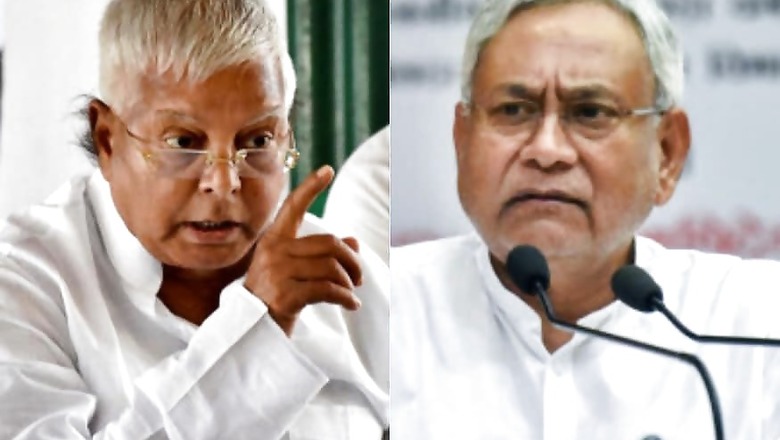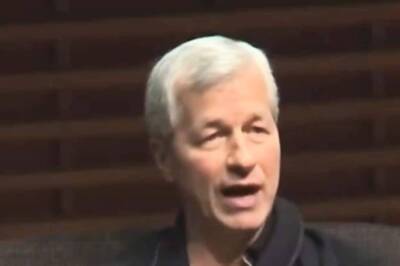
views
Patna: A no-holds-barred poster war has begun in Bihar between the opposition Rashtriya Janata Dal and the ruling Janata Dal (United), with the two parties taking on each other on a host of issues. The tussle indicates that the next assembly elections – to be held in October-November this year – will be fought on the 15-year rule of Nitish Kumar versus the previous 15-year regime of Lalu Prasad-Rabri Devi duo.
The poster war began after a billboard comparing the Lalu era with Nitish’s term appeared at the JD(U) office in the state capital. While the hoarding lauded the Nitish Kumar government as a period of progress and development, it lampooned Lalu Prasad through cartoons, underscoring his involvement in the fodder scam.
The RJD too put up posters outside its headquarters, featuring cartoons of chief minister Nitish Kumar and deputy chief minister Sushil Kumar Modi carrying baskets on their heads. “Jhooth ki tokri, ghotalon ka dhandha (A basketful of lies, business of scams) read the accompanying text.
This belligerent stance of the RJD may have been driven by its alliance’s recent victory in the Jharkhand polls but its tryst with political power in Bihar appears to be a difficult proposition because the Congress and other constituents of the so-called Mahagathbandhan, or Grand Alliance, appear disorganised and their leaders nurture vaulting political ambitions.
Besides the RJD and Congress, the coalition comprises the Rashtriya Lok Samata Party (RLSP) led by former union minister Upendra Kushwaha, Hindustani Awam Morcha (HAM) of former chief minister Jitan Ram Manjhi and Vikassheel Insaan Party (VIP) headed by Bollywood set designer Mukesh Sahani.
There appears to be no unanimity over the issue of leadership and the chief ministerial face among five constituents of the Grand Alliance even though they will have to face a towering and Machiavellian rival in Nitish, who is backed quite solidly by the BJP.
Against this backdrop, if the Grand Alliance intends to seize power in this year’s assembly elections, its constituents will have to first unanimously project a leader for the post of chief minister who can match the persona of Nitish Kumar. So far, RJD leader Tejashwi Yadav has not been able to prove his mettle as a potential challenger.
Consequently, the goal of trouncing the BJP-led National Democratic Alliance (NDA) in Bihar appears to be too high a proposition to accomplish as the performances of the Grand Alliance parties in the last Lok Sabha elections have been awfully poor and discouraging. Some of them like the VIP have not yet opened its legislative account as MLA or MP, though it claims to have substantial support among a section of the Extremely Backward Classes (EBCs) in Bihar.
The recent overtures of state RJD president Jagdanand Singh that Tejashwi Yadav will be the chief ministerial candidate and the jailed Lalu Prasad will be the coordinator of the Grand Alliance has also ruffled the feathers of the constituents. They have rejected it outright saying a seat-sharing formula and the leadership issue will be decided at the meeting of the Grand Alliance before the polls.
While Congress leader in the state assembly Sadanand Singh described Tejashwi as leader of the RJD and not of the Grand Alliance, HAM leader Jitan Ram Manjhi supported a proposition to bring Nitish back into the Mahagathbandhan fold before the assembly polls. Manjhi, however, was sceptical on whether Nitish was in a position to dump the BJP at this time.
Amid faltering stances on the leadership issue, the RJD has announced that it will contest no less than 150 of the total 243 assembly seats in the polls and leave only 93 for the four allies. It has taken this decision in view of the poor percentage of votes gained by the constituents in last year’s parliamentary elections.
"We have taken lessons from the debacle in the last Lok Sabha elections. We had conceded far more seats to the allies than they deserved actually. Most of their candidates were worthless and could not put up a challenge to the NDA nominees. The RJD has strong candidates in most of the constituencies,” said Jagdanand Singh.
In the 2019 Lok Sabha polls, the RJD contested 20 of the state’s 40 Lok Sabha seats, leaving nine for the Congress, five for the RLSP and three each for HAM and VIP. The RJD had conceded one seat to the CPI-ML from its quota. But barring the Kishanganj constituency won by the Congress, no one could win any seat amid a strong wave in favour of the NDA.
The electoral fortunes of the RJD have not been creditable in the past two decades barring the 2015 assembly polls, which it fought under the leadership of Nitish Kumar with Lalu Prasad taking over the command of electioneering. The RJD and JD(U) had contested 101 seats each, leaving 41 for the Congress. The RJD won 81 assembly seats garnering 44.35 per cent votes, the JD(U) bagged 71 seats with 40.65 per cent votes and the Congress picked up 27 seats with 39.49 per cent votes.
The decline in the electoral performance of the RJD started from the February 2005 assembly polls when it could win only 75 seats out of the 210 it had contested and could garner a vote share of 25.07 per cent. The government formation could not materialise since no post-poll alliance could be worked out because of a hung assembly, leading to the imposition of President’s Rule in Bihar.
In the subsequent October 2005 polls, the RJD fought on 175 seats and won 54 with a 23.45 per cent vote share. The JD(U)-BJP combine emerged as a formidable force and formed the government with a comfortable majority.
The political fortunes of the RJD continued to plummet till the 2010 assembly polls when it could win only 22 seats out of the 168 it had contested. It polled 18.84 per cent votes, a slide of 4.61 per cent causing a loss of 32 seats from the previous polls.
The RJD had contested the 2010 assembly elections in alliance with the Lok Janshakti Party (LJP) while the Congress had gone in alone. Out of the 168 seats the RJD had fought for, it could win only 22 while the LJP netted only three of the 75 seats it had contested. The Congress had fielded candidates on all 243 seats but could win only four.
In the absence of patriarch Lalu Prasad, the RJD faces an acute void of leadership. So, if the Grand Alliance wants to capture power, it will have to eschew differences, stand united and arrive at a consensus on every issue – from leadership to seat-sharing – so that its perceived vote base remains intact.
The allies will have to understand their real strength and adjust with proportionate constituencies while the RJD, as leader of the Grand Alliance, will have to abandon its adamant stance on the number of seats.



















Comments
0 comment